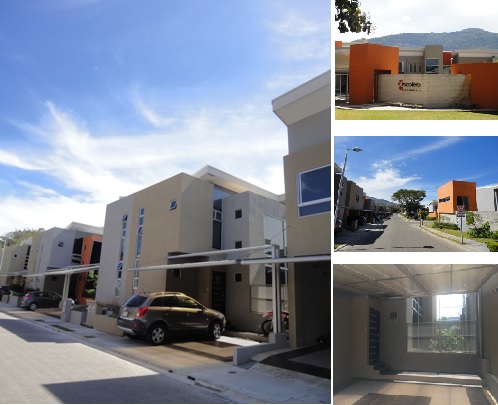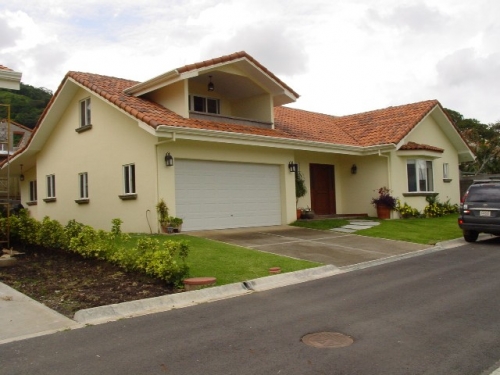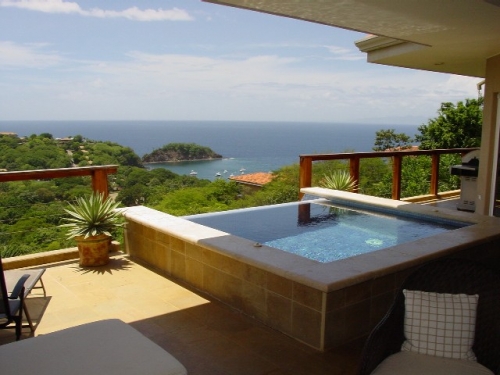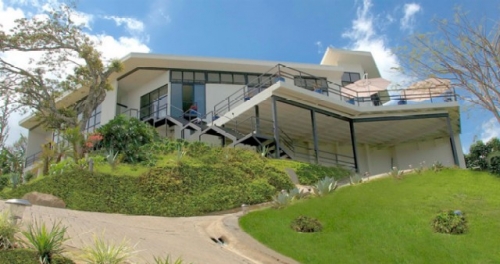Costa Rica Guide
Costa Rica Real Estate
List your property today!
Inclusion of real estate listings at Costa Rica Guide is
absolutely free of charge.
Featured Properties
Costa Rica Guide - Costa Rica Real Estate
Costa Rica Country Profile
Costa Rica receives more than 1.7 million tourists yearly and this number has been growing 7% annually.
More than half of these visitors come from North America and almost 20% come from Europe. Currently tourism is a $1.7 billion industry in Costa Rica. The increase in visitors has led to major programs to improve infrastructure which have subsequently led to increases in property value and investment. Still, there is room for more improvements and property values should continue to rise as more major development programs are undertaken.
Major hotel chains such as Four Seasons, Starwood and Marriot are already in Costa Rica, and massive resort projects are being undertaken. One such project is a joint endeavor by Steve Case, former owner of AOL, and tennis star Andre Agassi. This project, in the Gulf of Papagayo Guanacaste, has over $800 million dollars invested and will bring extremely high end tourism to the country.
Costa Rican tourism will continue to expand with the increase of eco-tourism throughout the world. Yearly, as a result of fears from global climate change, increasing numbers of tourists are beginning to focus their vacations on natural areas with massive amounts of biodiversity. Tourists are forgetting about typical beach vacations and trading them in for natural wonders. Costa Rica is one of the few places in the world that is able to offer standard relaxing vacations, as well as cater to those individuals who are joining the eco-tourism trend. With national parks covering 25% of the land, as well as pristine white and pink beaches, Costa Rica will be a major tourist destination for years to come.
Costa Rica has the highest education level in Central America. Over 90% of Costa Ricans are literate and most receive at least six years of schooling. This high level of education will help foster continued growth and development in Costa Rica. As more corporations look to establish offices and production facilities outside of the United States many will follow the lead of companies like Intel, Proctor and Gamble and Microsoft, by taking advantage of Costa Rica’s high literacy level.
Costa Rica’s economic and political stability, blossoming tourist industry and ideal location directly in the center of the Americas has helped Costa Rica experience economic growth in recent years. With the future privatization of government run utilities growth will undoubtedly continue. The current GDP is $49 billion and $12,000 per capita, less than one third of which is from government spending.
While Costa Rica exports the standard Central American produce and textile commodities, a great deal of growth is resulting from the increase in foreign investment. Recently, Costa Rica cut off ties with Taiwan in order to foster a better trade relationship with China. Chinese investment has begun with the planned construction of a major refinery, and the Arias Government appears intent on maintaining a positive longstanding diplomatic relationship.
High education levels, low costs of living and a cheap labor force have led to foreign corporations setting up manufacturing and call centers in Costa Rica. This has led to increases in real estate value in the Central Valley, while tourism has made the coastal areas prime real estate investments as well. Still, values will continue rising as more North Americans and Europeans arrive for corporate offices, and eco-tourists take advantage of all Costa Rica has to offer. Infrastructure is constantly improving, and savvy investors may be able to take advantage of future improvements.
CAFTA, or the Central American Free Trade Agreement, is a trade agreement between Central American nations, and the United States. The agreement is similar to NAFTA, an agreement between the US, Canada, and Mexico, which was enacted in 1994. Costa Rica accepted CAFTA in November 2007 following a national vote. CAFTA will lead to increases in American investment in Costa Rica because it will encourage Costa Rica to allow private companies to freely compete with the current government monopoly on utilities. American businesses will feel safe investing in Central America because CAFTA will protect their interests under the rules of free trade. CAFTA will also lead to further improvements in infrastructure as a result of the competition for contracts that is a natural result of free trade.
Costa Rica’s current government has emphasized the importance of improving infrastructure. Testaments from visitors who had not been to Costa Rica in years are full of amazement at how much the roads have already improved in such a short time, and these types of improvement will only accelerate in the near future.
Two major highway projects are currently underway which will make both Guanacaste and the Central Pacific Coast more accessible. Marina’s exist along the Pacific Coast, and more are in the works. There are also plans for a new modern terminal in the Liberia airport in Guanacaste which will allow visitors and residents to avoid traveling to the central valley before arriving at their destinations.
Costa Rica has long been seen as a natural treasure, which boasts more than one million tourist visits each year. The country, located in Central America, is an isthmus where life seems to have created its roots and natural beauty has no limits.
Covering only 0.03 percent of the planet’s surface, Costa Rica has approximately 6 percent of the world’s biodiversity. Breathtaking scenic beauty, a consolidated system of protected areas, social and political stability, high educational levels, and efficient infrastructure and services best describe Costa Rica.
The country’s strategic position in the heart of the Western Hemisphere as well as the governmental and political stability, make Costa Rica an ideal place to visit and establish commercial operations that may include industries centered on security such as business warranty and home insurance, among others.
Costa Rica is a peaceful country, proud of its prosperous democracy, respect for human rights and stable political system. With an unmatched blend of rich biodiversity, friendly culture and tranquil setting, visitors to this country will find friendly faces and an abundance of activities to satisfy all tastes.
Costa Rica’s facilities and convenient tourist amenities make it the ultimate travel destination.
Many flights arriving in Costa Rica land at Juan Santamaría International Airport (tel. 443-2682), 16 km (10 miles) north of downtown San José. From New York, flights to San José are 5 1/2 hours (via Miami); from Los Angeles, 8 1/2 hours (via Mexico); from Houston, 4 1/2 hours (via Guatemala); from Miami, 2 hours (direct).
U.S. Carriers: Major international airlines flying into San José include: American Airlines (tel. 800/433-7300), Aviateca Guatemala (tel. 800/327-9832), Continental (tel. 800/231-0856), Lacsa Costa Rica (tel. 800/225-2272), LTU (tel. 800/888-0200), Mexicana (tel. 800/531-7921), TACA El Salvador (tel. 800/535-8780), United (tel. 800/827-7777), and USAirways (tel. 800/428-4322).
U.K / Europe Carriers: From the U.K. American Airlines (tel. 0345/789-789) flies from Heathrow via Miami, one of the fastest options given that there are no non-stop flights to Costa Rica from the United Kingdom. British Airways (tel. 0345/222-111) and Iberia (tel. 0171/830-0011) offer flights to Madrid, changing to an Iberia flight to San José, Costa Rica. Virgin Atlantic (tel. 01293/747-747) goes from Gatwick to Miami, changing there.
Once You're Here
Going to San José by Bus: The bus marked "Ruta 200 San José" will drop you at the west end of Avenida 2, close to the heart of the city.
By Car: Driving time is about 20 minutes, but allow 40 minutes to be safe. Note that some hotels provide a free shuttle service--inquire when you book.
By Taxi: Taxis from the airport to downtown cost around $10. Beware of taxi drivers eager to take you to a hotel they know, which no doubt pays them a hefty commission.
Now, how do I get around?
By Bus: San José has no central bus station--a patchwork of private companies operates from a variety of departure points. Tickets are sold at the bus station or on the buses themselves. Information about schedules and where buses leave from can be found at the tourist office in San José.
By Car : San José is the hub of the national road system. Paved roads fan out from Paseo Colón left to Escazú, or right to the airport, the Pacific coast, Guanacaste, and Nicaragua via the Inter-American Highway. Calle 3 runs into the highway to Guápiles, Limón, and the Atlantic coast. If you follow Avenidas Central or 2 east through San Pedro, you'll enter the Inter-American Highway south, which has a turn-off for Cartago, Irazú Volcano, and Turrialba, before heading over the mountains to the Southwest and Panama.
There are plenty of would-be Mario Andrettis on Costa Rican highways; be prepared for hare-brained passing on blind corners, tailgating, and failures to signal. Watch out, too, for two-lane roads that feed into one-lane bridges with specified rights of way. And finally (and most importantly), look out for potholes, even in the smoothest sections of the best roads. A 4x4 is your best bet when renting a car.
Brochures
General Information [Adobe Acrobat document]
Beaches 1 2 3 4 [Adobe Acrobat documents]
Vacations 1 2 3 4 [Adobe Acrobat documents]
Ports [Adobe Acrobat document]
Fishing 1 2 [Adobe Acrobat documents]
Surf 1 2 [Adobe Acrobat documents]
Health 1 2 3 4 [Adobe Acrobat documents]
Honeymoon [Adobe Acrobat document]
Documents
Tourism in Costa Rica - Introduces the reader to activities of the Costa Rica Tourism Institute (ICT), the maritime zone, the Papagayo Gulf tourism project. [Adobe Acrobat document]
Archived Information
2000 Statistics - [MS Excel document - In Spanish]
2004 Statistics -[MS Excel document - In Spanish]






